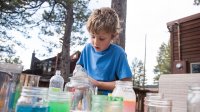Using Human-Centered Strategies to Adapt Science Lessons for Remote Learning
By coordinating with families and keeping things simple, K–8 teachers can guide students to engage in meaningful science lessons at home.
Your content has been saved!
Go to My Saved Content.Kids learn by doing. So what does that mean for science instruction in the age of Covid-19, when many schools are closed and children are learning from home? It’s embracing the uncertainties, shifting mindsets and expectations, and finding a new learning landscape.
The shift to at-home learning should not mean skipping core content. While disruptive, the pandemic offers an unexpected opportunity to rethink, redefine, and reimagine what STEM teaching and learning can look like for students. It involves teaching science in a way that engages and stimulates students without overwhelming them or their families. This calls for taking a human-centered approach—placing people at the center of the process and relinquishing past formulas for new, bold solutions. We will set new expectations for our students, their families, and ourselves to center on the joy and wonder of learning.
5 Keys to Building Connections and Engaging Students in Science During Distance Learning
We distilled these learning strategies from extensive listening sessions and surveys with teachers, administrators, parents, and students.
1. Keep it simple: Distance learning will often rely on parents and caregivers to lead children through activities, so keep the instructions and goals simple. Focus activities and prompts on noticing and wondering—more than on making sure everything is completed correctly.
The Institute for School Partnership at Washington University in St. Louis launched learn-at-home science lessons for students ages 4 to 14. Resources like Everyday mySci and STEM Challenges give curious kids opportunities to explore, problem-solve, design, and create. Additionally, one of our partners, MilliporeSigma, a global life sciences company, created free and interactive science experiments to spark curiosity through its Curiosity Labs at Home platform, which requires only some basic household items.
Setting up for the activity can be part of the learning experience. For example, finding household materials to complete an activity can be a mini-design challenge for students rather than a stressful preparation task for their parents (e.g., ask what stuff they have in their home that they can use for this activity).
2. Build relationships with families: Consider the devices and platforms you’re using and how students have access to materials. This includes instructional materials, lessons, and the student learning environment. Many students will have access to materials and communication platforms only through their parents or caregivers. Take the time to build trusting relationships with students’ families to facilitate learning throughout the year. As families are juggling supporting distance learning, their own work, and other challenges posed by the pandemic, those strong relationships can protect against added stress and help avoid miscommunication.
One strategy is to establish regular office hours for caregivers to check in. This helps set boundaries on the teacher’s time while also giving families peace of mind and reassurance that they’re not missing something important. It also reduces barriers for families, enabling them to show up without needing to make an appointment first.
3. Rely on routines: Follow routines that kids can rely on for synchronous and asynchronous learning time. Routines can help set expectations and help children (and adults) feel safe. When something unexpected comes up, which it will, students can use the routine to quickly orient themselves to their work. As you would in your in-person classroom, organize your virtual classroom: make agendas and assignments visible, provide clear and consistent instructions for how and when to join it, set expectations for where students should turn in work, and discuss how they will receive communication.
Routines can also include relationship building, like starting class with a one-word check-in, which breaks down emotional barriers and reduces stress. Building in time for students to socialize and play can be an important part of learning as well, especially in STEM. Some ideas include Minute to Win It style games, which can be done virtually and get kids laughing while solving engineering challenges.
4. Focus on formative assessment: Remote learning makes it harder to check in with students or use nonverbal cues to gauge understanding. Give opportunities for productive discussion and visible sense making whether students are working synchronously or asynchronously. Find ways to have students actively participate in lessons using tools like Jamboard, Google Slides sticky notes, break rooms, and digital journals. These strategies make learning visible to all students and provide excellent opportunities for assessing student knowledge during the lessons rather than waiting until a summative test.
5. Adapt hands-on labs: Socially distant hands-on activities present unique challenges at every grade level. When it’s not possible to have students complete labs at home, you can use virtual labs available online so that students can still experience the feel of observing lab outcomes. You can also film yourself doing the labs or show lab results live during synchronous instruction. Students prefer seeing their teacher’s face and voice as opposed to a stranger’s. Allow students to analyze the data and construct explanations based on what they observe from videos or your demonstration.
Navigating the new normal of education during Covid-19 will be hard, but it can be the opportunity to rewrite playbooks, redefine success, shift our paradigm, and focus on the human connections along with the wonder and joy in STEM.

